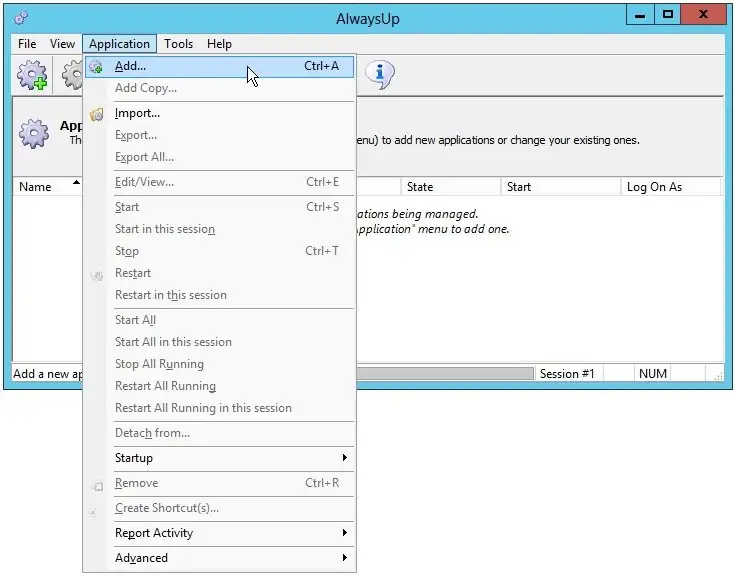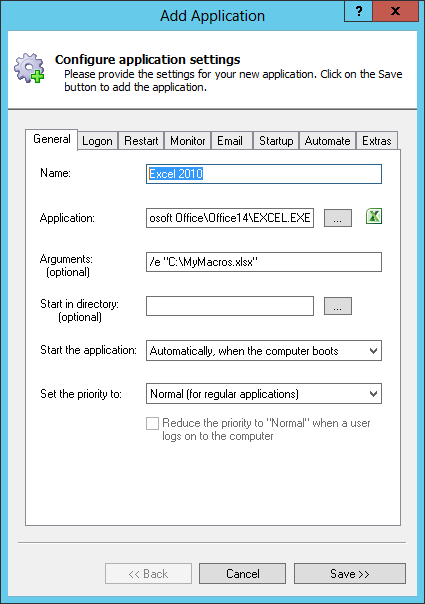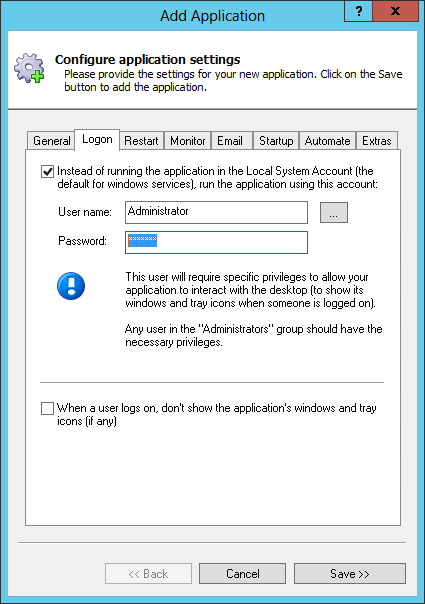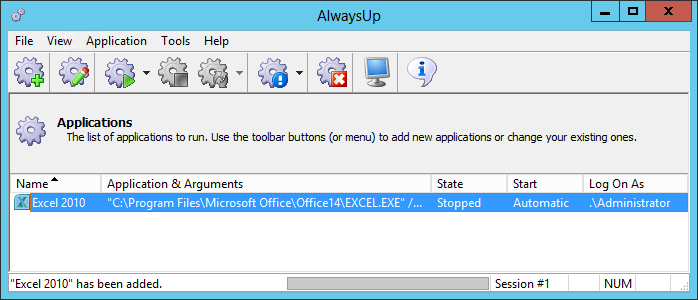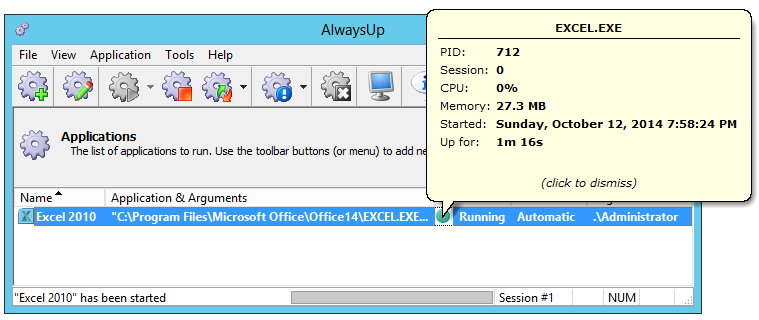
|
How to Run Microsoft Excel 2010 as a Windows Service with AlwaysUp |
Start your MS Excel macros and automation in the background when your PC reboots, without anyone having to log on
Microsoft Excel is the world's most popular spreadsheet software for desktop PCs.
Excel 2010 is a core component of the equally popular Microsoft Office 2010 suite of productivity applications.
Note: Microsoft cautions against running any program in its Office suite as a Windows Service.
However the most notable problems arise when running in the LocalSystem account and AlwaysUp can get around that. Nevertheless, please be
sure to thoroughly test your setup to ensure that Excel works as expected.
To setup Excel 2010 to start in the background as a Windows Service with AlwaysUp:
-
Download and install AlwaysUp, if necessary.
-
Start AlwaysUp.
-
Select Application > Add to open the Add Application window:
-
On the General tab:
-
In the Application field, enter the full path to the Excel 2010 executable, EXCEL.EXE.
If you installed Excel (or Office) in the default location, this is:
C:\Program Files\Microsoft Office\Office14\EXCEL.EXE
or
C:\Program Files (x86)\Microsoft Office\Office14\EXCEL.EXE
on a 64-bit version of Windows and with the 32-bit version of Office/Excel installed.
-
In the Arguments field, enter any
command line parameters
you need to start Excel.
For this tutorial, we'll specify:
- the /e flag, which prevents the Excel startup screen from appearing, and
- the full path to the workbook file containing the macros we wish to run (C:\MyMacros.xlsx). Be sure to use your own path, enclosing it in double quotes (") if it contains a space.
-
In the Name field, enter the name that you will call the application in AlwaysUp.
We have specified Excel 2010 but please feel free to enter something more descriptive of your situation.
-
Click over to the Logon tab and enter the user name and password of the account in which you installed and configured Excel (or Office) 2010.
Excel must run in this account so that it can find its configuration & settings. Excel will not work properly if you don't do this!
-
We are now done configuring your Excel 2010 application so click the Save button to record the settings.
In a couple of seconds, an application called Excel 2010 will show up in the AlwaysUp window.
It is not yet running though.
-
To start Excel 2010 and run your workbook file, choose Application > Start "Excel 2010". In a few seconds, the state should move to Running and Excel will be doing its thing in the background.
Click on the green circle will reveal a few details on the running process:
Note that on Windows 8.1/8/7/Vista and Server 2012/2008, Excel will be running in the
Isolated Session 0.
Choose Tools > Switch to Session 0 to temporarily switch to the strange looking Session 0 desktop where Excel will be visible.
You can also choose Application > Start "Excel 2010" in this Session if you wish to start Excel visible on your desktop - which may be useful when debugging startup problems.
-
That's it! Next time your computer boots, Excel 2010 will start up immediately, before anyone logs on.
We encourage you to edit Excel in AlwaysUp and check out the many other settings. For example, run your workbook periodically instead of 24/7, use automation to dismiss alert dialogs, and much more.
Excel 2010 not working properly as a Windows Service?
-
Consult the AlwaysUp Troubleshooter - our online tool that can help you resolve the most common problems encountered when
running an application as a windows service.
-
From AlwaysUp, select Application > Report Activity > Today... to bring up a HTML report detailing the interaction between AlwaysUp and Excel.
The AlwaysUp Event Log Messages page explains the more obscure messages.
-
Running Excel in the background unattended can be tricky, especially when it throws up a prompt that
interrupts the action. If these can not be eliminated from your code, you may want to investigate using an automation script/program
to automatically dismiss the pesky windows. Please see the
Automate tab
(or the AlwaysUp User's Manual)
for additional information on automation.
- Review the AlwaysUp FAQ for answers to commonly asked questions and troubleshooting tips.
- Contact us and we will be happy to help!
|
Over 97,000 installations, and counting!
|
 |

|
Rock-solid for the past 20+ years!
|
Fully Compatible with 160+ Applications...
|

